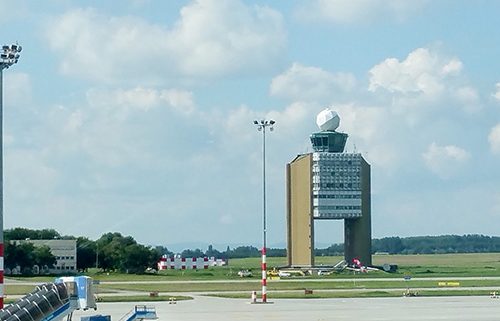HungaroControl, Hungary’s national air traffic control organisation, recently set up at Budapest Airport a Remote Tower to replace the airfield’s ageing control tower. The new centre houses numerous monitors and one huge video wall that receive images from highly sensitive cameras mounted on the roof of the old control tower. Building this centre obviates the need for investment in the old tower and at the same time contributes to more efficient air traffic control at a lower cost. But how are air traffic controllers coping with all of this new equipment in the Remote Tower, and how does their behaviour differ from the situation they were working in the old tower? HungaroControl chose NLR-Netherlands Aerospace Centre to study this because of NLR’s extensive knowledge of human factors. The conclusions and recommendations of the study must assure a safe and smooth transition from the old to the new ‘tower’ in Budapest.
Air traffic controllers who work in a control tower supervise aircraft that are taking off, landing and taxiing. They do this by using radar and their own view over the airport. At the new HungaroControl remote tower centre, a large video wall has replaced the normal out of the window view from the tower, but the video wall also offers a different perspective of the airport compared with the one from the old tower. How are air traffic controllers dealing with this situation, what do they zoom in on, and do they respond in time to all relevant information? NLR is carrying out the study with the help of ‘eye tracking’ and heart rate measurement equipment to determine which information the air traffic controllers attend to, how and when they do so, and how this affects their mental workload.
Innovative technology is increasingly becoming commonplace in control towers. High-definition video cameras capable of zooming in very sharply and high-resolution video screens have made it technically possible to remotely control the air traffic that occurs around airports. NLR is conducting research into this Remote Tower technology, using the technology at a remote centre that replaces the tower, as in Budapest, but also at a centre from where multiple airports are controllable simultaneously. In summer 2016, for example, NLR and LVNL-Netherlands Air Traffic Control jointly studied the Remote Tower concept in the Netherlands, with LVNL controlling airports including Groningen-Eelde from Amsterdam Schiphol-East.
The Remote Tower concept helps to make the deployment of air traffic controllers and the management of air traffic more efficient. Moreover, it gives air traffic controllers a tool for controlling smaller, more remote airfields as well, thus making a region more easily accessible and stimulating regional economic development.



